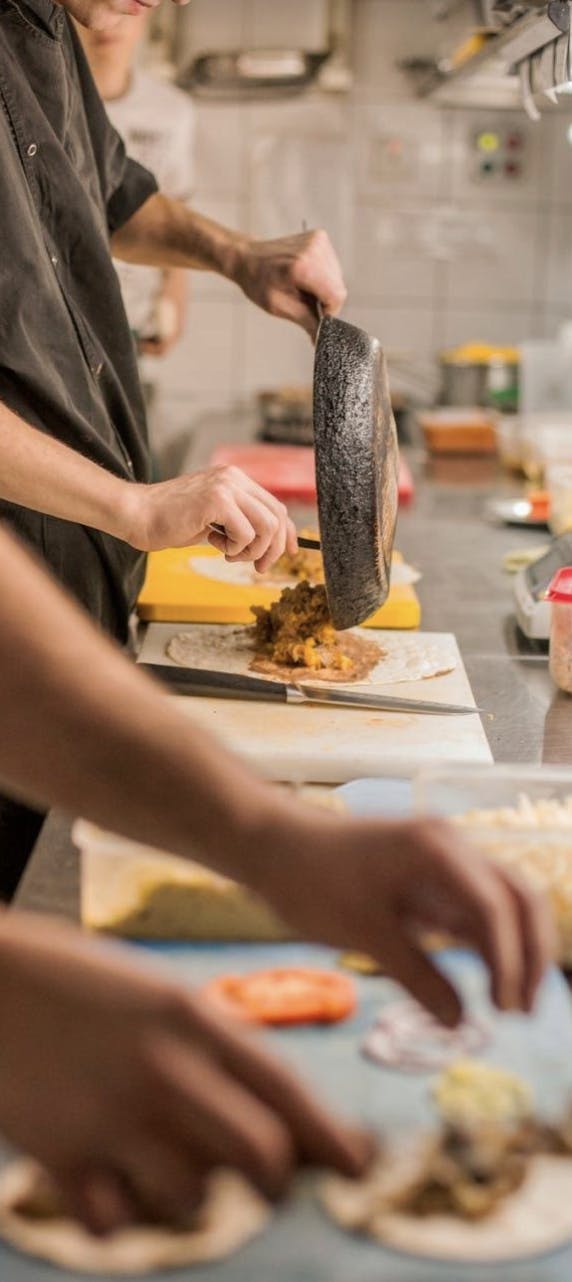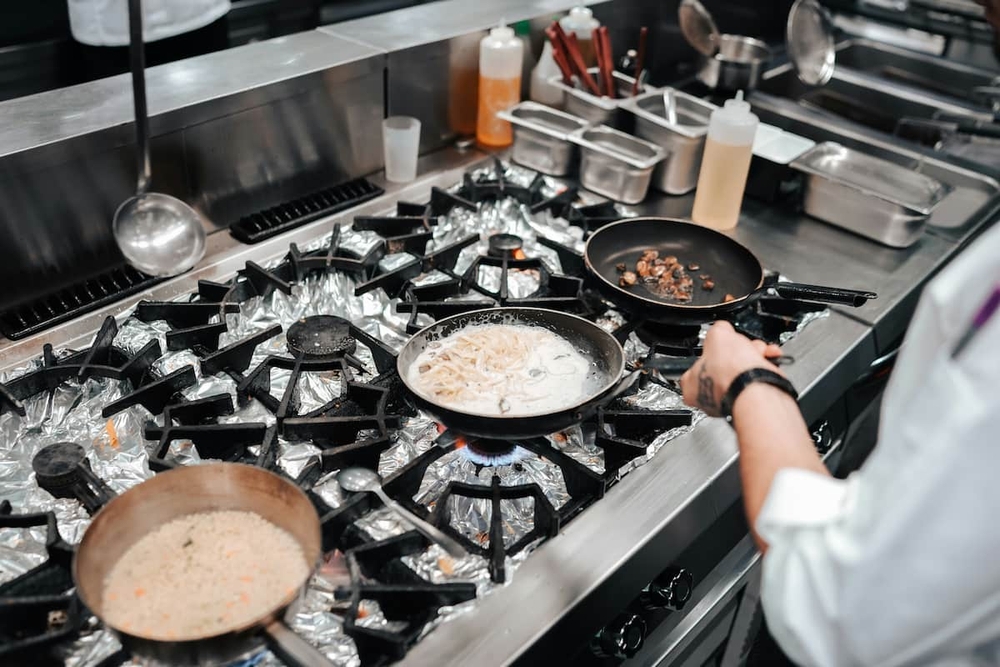The ultimate guide to training your kitchen staff for speed and accuracy
Table of Contents
CloudKitchens
How many tacos can be delivered from a 1000sqft restaurant?
The same amount as a 200sqft ghost kitchen.
The success of any restaurant heavily depends on its kitchen staff’s ability to work quickly and accurately. Proper training not only enhances efficiency but also ensures food quality and customer satisfaction. In this guide, we’ll cover essential kitchen management practices, staff responsibilities, and effective training strategies to boost kitchen performance.
What is kitchen management?
Kitchen management involves overseeing kitchen operations to maintain efficiency, quality control, and safety. It encompasses various aspects, including food preparation, staff coordination, hygiene compliance, and inventory management. Effective kitchen management ensures a good service, minimizes waste, and enhances profitability.
That’s why it is important to follow standardized workflows and utilize technology to streamline operations. From order tracking to ingredient storage, a structured approach is crucial to sustaining high performance in a fast-paced environment.
Read more: From prep to profit: how to optimize food production in ghost kitchens
The essential role and importance of kitchen staff
Kitchen staff are the backbone of any restaurant. Their responsibilities go beyond cooking; they ensure that food safety regulations are met, ingredients are handled properly, and customer expectations are exceeded. Without well-trained kitchen staff, a restaurant may struggle with delays, mistakes, and customer dissatisfaction.
Importance of kitchen staff:
- Maintaining food quality: Trained staff ensure that dishes are prepared according to standardized recipes, preserving flavor and presentation.
- Ensuring hygiene and safety: Proper food handling techniques reduce the risk of contamination and foodborne illnesses.
- Enhancing customer satisfaction: Quick and accurate service leads to positive reviews and repeat customers.
- Optimizing workflow: A well-coordinated team can handle high-order volumes efficiently, reducing wait times.
- Reducing waste: Proper portion control and inventory management minimize food waste and improve cost efficiency.
How to improve the performance of kitchen staff
Enhancing the efficiency of kitchen staff requires a combination of structured training, clear communication, and the right tools. Below are key strategies to improve their performance:
1. Provide structured training programs
A structured training program should include hands-on learning, mentorship, and detailed guides on food preparation techniques. Regular refresher courses help employees stay updated on new processes and technologies.
2. Establish clear workflows
Defining clear roles and responsibilities prevents confusion and improves coordination. Implementing a well-organized station system ensures that each employee knows their tasks, leading to faster preparation times.
3. Use technology for efficiency
Modern kitchen management software helps streamline order processing, reducing errors and speeding up service. Automated kitchen display systems (KDS) improve communication between the front and back of the house.
4. Conduct regular performance assessments
Assessing employees’ strengths and areas for improvement helps identify skill gaps. Providing constructive feedback and additional training can enhance efficiency and accuracy.
5. Encourage teamwork and communication
Strong communication fosters a positive work environment. Encouraging teamwork through regular team meetings and open communication channels improves coordination and reduces misunderstandings.
Read more: Restaurant hiring/staff 101: Comprehensive guide
What responsibilities does a kitchen manager have?
A kitchen manager plays a crucial role in overseeing daily kitchen operations, ensuring that everything runs smoothly. Their responsibilities include:
- Supervising kitchen staff: Ensuring that all employees follow standard operating procedures and perform their duties efficiently.
- Managing inventory: Keeping track of food supplies, ordering ingredients, and minimizing waste.
- Ensuring food safety and hygiene: Implementing strict cleanliness and sanitation protocols.
- Optimizing workflows: Organizing kitchen stations and streamlining food preparation processes.
- Handling staff training and development: Providing ongoing training to improve skills and performance.
- Monitoring quality control: Ensuring that all dishes meet restaurant standards before being served to customers.
A strong kitchen manager leads by example, fostering a disciplined yet supportive kitchen culture.
Best tips for effective kitchen management with speed and accuracy
Improving speed and accuracy in the kitchen requires practical strategies and continuous optimization. Here are some expert tips to enhance kitchen performance:
1. Implement a prep-first approach
Encouraging chefs to complete as much prep work as possible before peak hours minimizes delays and keeps the workflow smooth. Prepping ingredients, measuring portions, and organizing mise en place can significantly cut down on cooking time during service hours.
2. Organize workstation layouts efficiently
A well-organized kitchen layout prevents congestion and allows staff to move seamlessly between stations. So, keeping frequently used ingredients and tools within easy reach saves time. Designating specific zones for different tasks (prep area, cooking area, plating station) enhances efficiency and reduces bottlenecks.
3. Utilize a kitchen display system (KDS)
A digital KDS helps eliminate miscommunication between waitstaff and kitchen staff, reducing errors and speeding up order fulfillment. These systems provide real-time updates and allow chefs to prioritize tasks effectively, ensuring smooth kitchen operations.
4. Train staff on multitasking
Employees should learn how to handle multiple tasks simultaneously without compromising quality. Cross-training staff members ensures flexibility during busy shifts, allowing team members to step in when needed. Encouraging kitchen staff to clean as they go, monitor cooking times, and prepare side dishes while main courses cook can improve efficiency.
5. Monitor cooking times
Encouraging consistency in cooking times helps maintain efficiency. Chefs should use timers and follow standardized recipes to ensure dishes are cooked perfectly every time. Implementing cooking guidelines for common dishes helps avoid delays and maintains uniform quality.
6. Establish a clear communication system
Using headsets, kitchen buzzers, or color-coded tickets can improve communication between team members, ensuring smooth coordination. A clear communication system minimizes misunderstandings, reduces errors, and keeps kitchen operations flowing seamlessly.
7. Maintain a clean and organized workspace
A clutter-free environment boosts efficiency and reduces the chances of accidents or misplaced ingredients. Regularly cleaning and organizing workstations, checking for expired ingredients, and enforcing a “clean as you go” policy help maintain a safe and productive kitchen.
8. Use technology for inventory and ordering
Implementing an automated inventory management system can reduce food waste and prevent stock shortages, for example. Ensuring that kitchen staff have access to real-time inventory updates helps streamline operations and maintain ingredient availability during peak hours. That’s why you must use technology in your kitchen.
9. Encourage a team-oriented culture
A positive team environment leads to higher efficiency and better morale. Encouraging staff collaboration, offering incentives for high performance, and conducting regular team-building activities can improve overall kitchen productivity.
Read more: Social media marketing guide & tips for restaurants
How CloudKitchens can help streamline your kitchen operations
Training kitchen staff for speed and accuracy is essential for running a successful restaurant. By implementing structured training programs, optimizing workflows, and utilizing technology, restaurants can improve efficiency and enhance customer satisfaction. Proper kitchen management ensures that every dish meets high-quality standards while maintaining quick service times.
At CloudKitchens, we provide state-of-the-art kitchen solutions that help restaurants optimize their operations, reduce costs, and improve service speed. Our technology-driven approach ensures that your kitchen staff can work efficiently while maintaining high accuracy.
Ready to enhance your kitchen operations? Learn more about CloudKitchens today!
DISCLAIMER: This information is provided for general informational purposes only and the content does not constitute an endorsement. CloudKitchens does not warrant the accuracy or completeness of any information, text, images/graphics, links, or other content contained within the blog content. We recommend that you consult with financial, legal, and business professionals for advice specific to your situation.
More insights & stories
There’s more where that came from.
Get in the know and check out our additional insights


